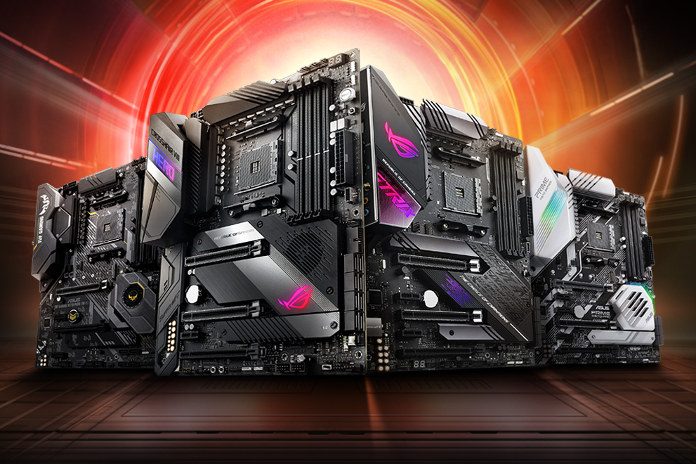Gather your belongings and move to the Republic of Gamers
The Republic of Gamers was founded way back in 2006, which is a long time ago in computing years. It redefined the meaning of “enthusiast motherboards” with the original Crosshair and has been evolving the formula ever since. Using top-notch components and cutting-edge designs capable of hitting the highest speeds, ROG engineers create motherboards that exude quality and craftsmanship while pushing the boundaries of desktop computing.
Our new Crosshair VIII models set the bar for X570 motherboards. The pack is led by the armor-clad and liquid-ready Crosshair VIII Formula, followed closely by the Crosshair VIII Hero for less extravagant builds. Overclocking fanatics and small system lovers can look to the Mini-DTX Crosshair VIII Impact, a compact board built to shatter records.
The Crosshair VIII Formula puts the biggest VRMs in town under liquid cooling
The Formula is the flagship of the X570 fleet, primed to be fitted into premium systems with custom liquid-cooling loops and push Ryzen to its limits. Whether you’re looking for utmost functionality or pure aesthetic expression, this board sits at the apex. It would look fantastic just displayed on a wall, let alone in a high-end build.

The liquid-fueled centerpiece is the mighty CrossChill EK III water block, a product of our ongoing collaboration with the cooling masters at EK Water Blocks. The block is tapped for standard fittings to ease its installation into an existing loop, and it sits atop one of our biggest VRMs to date. The 16 PowIRstages are accompanied by MicroFine Alloy chokes, with each stage capable of delivering a whopping 60 amps. There’s more than enough power to take a CPU to its limits. The ProCool ATX and eight-pin power headers with solid-core pins and metal covers ensure the board and VRMs get stable, uninterrupted power.
On the integrated I/O shield rests a LiveDash 1.3” OLED display, a handy tool for quickly getting information at a glance, like checking the CPU speed, keeping an eye on BIOS Flashback status, verifying POST codes in case of trouble, or monitoring the motherboard’s copious collection of sensors. Naturally, you can also roll your own custom graphics or display text. Monitoring is a prime aspect of managing a liquid-cooled system, and the Crosshair boards’ dedicated coolant flow rate and temperature headers let you track key metrics. A trio of dual-mode chassis fan headers stand ready, should extra cooling become necessary. Additionally, the Node connector lets attached components communicate their own readings and take control of board features.
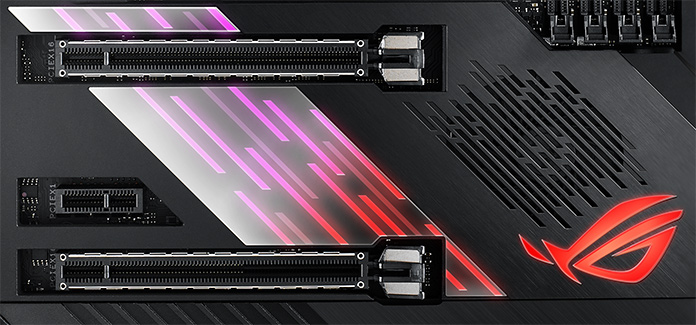
Networking aficionados will find the Formula fulfills their needs and then some. There’s an Intel Wi-Fi 6 adapter ready to send radio waves at multi-gigabit speeds, and next to the Intel Gigabit Ethernet chip sits an Aquantia 5G controller with much higher throughput for moving huge videos and other files. The SupremeFX S1220 codec and its associated circuitry offer audiophile-grade audio reproduction. An ESS Sabre DAC and amp powers the front panel audio output, ready to drive high-impedance hi-fi headphones without breaking a sweat.
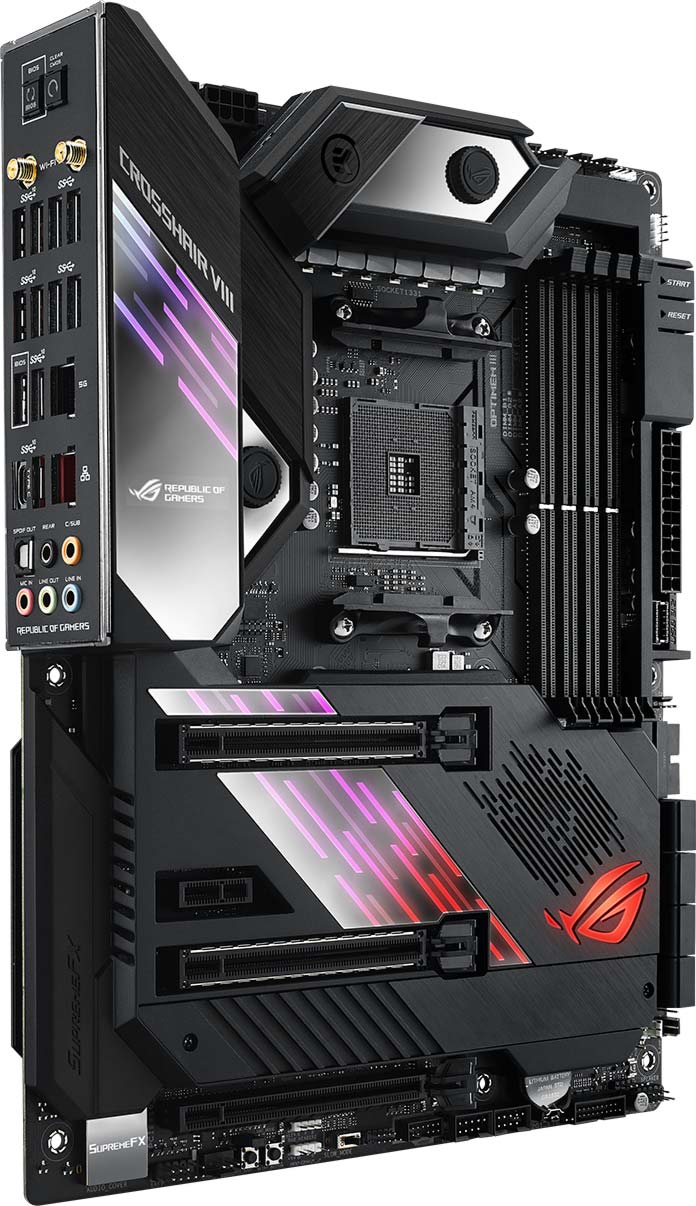
As befits the top model in the lineup, the Formula is reinforced by a metal backplate and SafeSlot treatment for its main PCIe x16 slots. The chipset is covered by an expansive heatsink, while the dual M.2 slots each have their own dedicated heatsinks, sitting underneath the board’s ROG Armor. Alongside headers for standard RGB LED strips, there are ASUS-developed Gen 2 headers for addressable strips. These headers can autodetect the characteristics of connected devices, allowing software to easily tweak effects to match. For added customization, FlexKey lets you remap the reset key to switch Aura Sync or off, boot directly into the UEFI, or Safe Boot with UEFI defaults.
The Formula also comes with a particularly generous allotment of USB ports: 12 at the back panel, and another 9 available through internal headers, including Type-C connectors. You can ditch your USB hub now.
| ROG Crosshair VIII Formula | |
|---|---|
| Size | ATX |
| Memory | 4 x DDR4 |
| Multi-GPU | 2 x SLI, 3 x CrossFireX |
| PCIe | 2 x16: x16, x8/x8 1 x16: x4 3 x1 |
| Storage | 2 x M.2 (NVMe x4 or SATA 6Gbps) 8 x SATA 6Gbps |
| Networking | Aquantia 5G Ethernet Intel I211AT Gigabit Ethernet 2x2 802.11ax (Wi-Fi 6) MU-MIMO Bluetooth 5 |
| Audio | SupremeFX S1220 codec |
| USB | 3.2 Gen 2: 1 x front, 1 x Type-C, 7 x Type-A 3.2 Gen 1: 4 x front, 4 x Type-A 2.0: 4 x front |
| Aura | 2 x strip headers 2 x Gen2 addressable headers |
| Cooling | 2 x pump headers 5 x fan headers 1 x high-amperage fan header 1 x coolant temperature sensor 1 x coolant flow rate sensor |
| Availability (USA) | Amazon Newegg |
| Availability (Canada) | Canada Computers |
If you’re building a liquid-cooled home for a new Ryzen CPU, the ROG Crosshair VIII Formula provides a premium foundation. From the design of the power circuitry and liquid-ready VRM cooler to aesthetic touches like the Gen 2 RGB headers and stylish armor, the Formula is the pinnacle of ROG X570 motherboards. Pricing and release date will be announced soon, so stay tuned.
The ROG Crosshair VIII Hero (Wi-Fi) offers glorious air-cooled excess without going overboard
Let’s say the liquid-cooled Formula catches your eye, but you prefer air-cooled rigs or factory-sealed AIO liquid coolers instead of custom loops. Your new best friend is the Crosshair VIII Hero.

Compared to the Formula, the Hero doesn’t leave much on the table. The voltage regulation module maintains the power stage count at 14+2 based on IR3555 ICs. The VRM heatsink has a massive surface area for better heat distribution. The chipset is covered by a large heatsink, and the two onboard M.2 slots each have their dedicated sinks, ensuring NVMe SSDs won’t see any thermal-induced throttling. You can assemble a similarly overpowered rig with the Hero as you can with the Formula, including two-way SLI and three-way CrossFireX setups set to take advantage of the extra bandwidth afforded by graphics cards with PCIe 4.0.
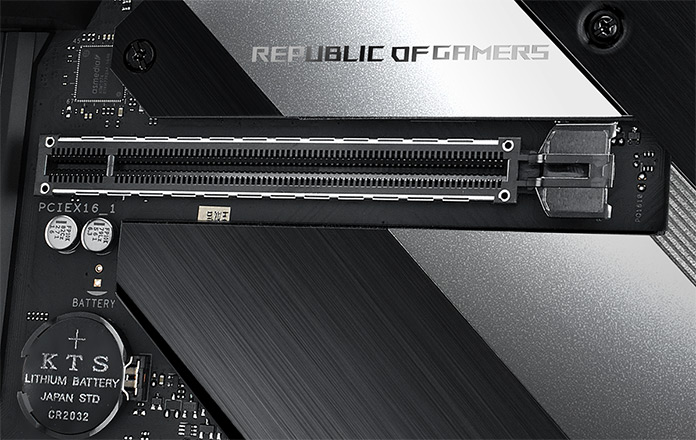
The stealthy PCB and gray accents meld perfectly with Aura Sync lighting, which is integrated into the PCH heatsink and I/O cover, and also supported through a total of two RGB headers plus two Gen2 addressable headers. An onboard Q-Code POST code display also lights up to help troubleshoot failed overclocks. Cooling arrangements can take advantage of plenty of hybrid fan headers, plus connectors for AIO pumps or custom loop pumps.
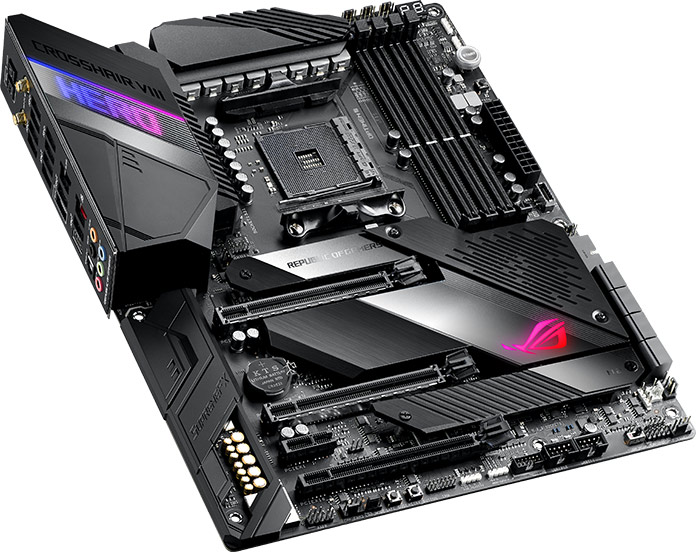
Unlike with the Formula, there’s no metal plate on the back or water block integrated into the VRM heatsink. The LiveDash OLED display is also gone. A 2.5G LAN chip takes the place of the Aquantia 5G controller, and you can opt for a version of the Hero that lacks the Intel Wi-Fi 6 adapter for a purely hardwired setup.
| ROG Crosshair VIII Hero (Wi-Fi) | |
|---|---|
| Size | ATX |
| Memory | 4 x DDR4 |
| Multi-GPU | 2 x SLI, 3 x CrossFireX |
| PCIe | 2 x16: x16, x8/x8 1 x16: x4 3 x1 |
| Storage | 2 x M.2 (NVMe x4 or SATA 6Gbps) 8 x SATA 6Gbps |
| Networking | Realtek 2.5G Ethernet Intel I211AT Gigabit Ethernet 2x2 802.11ax (Wi-Fi 6) MU-MIMO; Bluetooth 5 (optional) |
| Audio | SupremeFX S1220 codec |
| USB | 3.2 Gen 2: 1 x front, 1 x Type-C, 7 x Type-A 3.2 Gen 1: 2 x front, 4 x Type-A 2.0: 4 x front |
| Aura | 2 x strip headers 2 x Gen2 addressable headers |
| Cooling | 2 x pump headers 5 x fan headers 1 x high-amperage fan header 1 x coolant temperature sensor 1 x coolant flow rate sensor |
| Availability (USA) | Amazon Newegg |
| Availability (Canada) | Canada Computers Memory Express |
The ROG Crosshair VIII Hero is designed for air-cooled rigs and more conventional liquid cooling. If you’re not building with a custom liquid-cooling loop, the Hero is your ATX entry point into the Crosshair series. Expect more information on pricing and release date in short order.
The ROG Crosshair VIII Impact is a two-DIMM overclocker’s dream
You’d be forgiven for presuming that the biggest motherboards are the natural choice to take a CPU’s clock speed as far as it can possibly go, and perhaps shatter some world records in the process. That’s not always the case, though. The memory controllers inside modern CPUs are complicated, and trying to use four DIMMs in a board at maximum speeds can be challenging. A two-DIMM configuration is often the best path to memory tuning victory as it eases the load on the RAM controller and shortens the length of PCB traces to the slots. The stage is set for the ROG Crosshair VIII Impact.
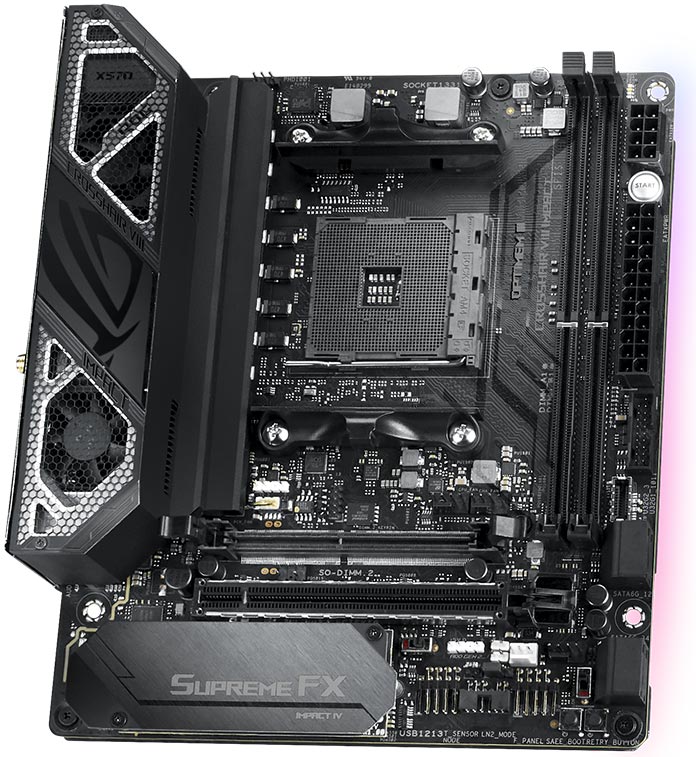
The Impact is a compact, high-performance motherboard based on the mini DTX form factor, which is slightly taller than Mini-ITX. The unusual dimensions were deliberately chosen to take advantage of unused space in Mini-ITX cases designed to support two-slot graphics cards mounted directly to the motherboard. The extra real estate helps us squeeze in additional features along with a VRM that uses TDA21472 power stages in an 8+2 configuration. Each stage is capable of pushing 70A to better feed power to high-end CPUs. To cool the VRM effectively as you turn the MHz up higher, the Impact uses a heatsink with an integrated fan ready to blow a breeze through the fins. A heatpipe connects the VRM sink to a full-size aluminum backplate, spreading out heat quickly and evenly, compensating for limited airflow in smaller chassis. Along with the standard CPU fan connector, the Impact comes with dedicated headers for a pump and two radiator fans, along with headers for monitoring coolant flow and temperature.
We didn’t skimp on features to fit into a smaller footprint; the Crosshair VIII Impact mostly matches its ROG siblings and only drops items that physically won’t fit, like multiple PCIe expansion slots and extra SATA ports that most people don’t need. There are still plenty of PCIe 4.0 lanes for next-gen SSDs, plus Intel-powered Gigabit Ethernet and Wi-Fi 6 networking. The board even has room integrated Aura Sync lighting along with a standard RGB strip header and two Gen 2 addressable strip headers.
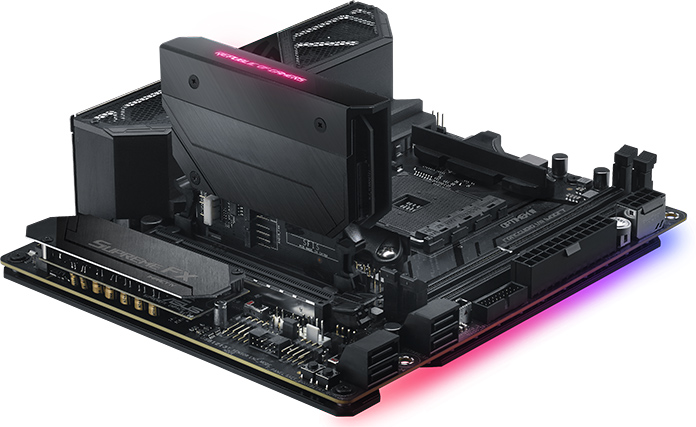
Since surface area is at a premium in this form factor, we create more of our own. The dual M.2 slots are mounted to a new ROG SO-DIMM.2 module that plugs into the board, the SupremeFX S1220 audio codec and its associated high-end circuitry sit on their own PCB, and the diagnostic LEDs, reset and CMOS buttons, and BIOS Flashback port relocate to the aptly-named Impact Control Card. You can use FlexKey to retask the reset button to toggle Aura Sync, boot directly into the UEFI, or trigger a safe boot with board defaults.
| ROG Crosshair VIII Impact | |
|---|---|
| Size | Mini-DTX |
| Memory | 2 x DDR4 |
| Multi-GPU | NA |
| PCIe | 1 x16 |
| Storage | 2 x M.2 (NVMe x4 or SATA 6Gbps) 4 x SATA 6Gbps |
| Networking | Intel I211AT Gigabit Ethernet 2x2 802.11ax (Wi-Fi 6) MU-MIMO; Bluetooth 5 (optional) |
| Audio | SupremeFX S1220 codec |
| USB | 3.2 Gen 2: 1 x front, 1 x Type-C, 5 x Type-A 3.2 Gen 1: 2 x front, 2 x Type-A 2.0: 2 x front |
| Aura | 1 x strip header 2 x Gen2 addressable headers |
| Cooling | 1 x pump header 4 x fan headers 1 x coolant temperature sensor 1 x coolant flow rate sensor |
| Availability (USA) | Amazon B&H Photo Video Micro Center |
| Availability (Canada) | TBA |
Whether you’re gunning for Ryzen overclocking records or simply want to build a small-form-factor PC whose size belies the power inside, the ROG Crosshair VIII Impact is the obvious option. Pricing and release date will be announced closer to general availability.

